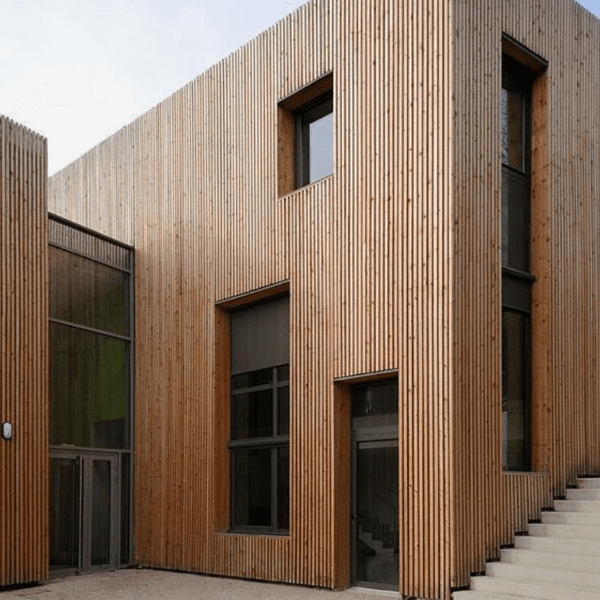No products in the basket.
Essential maintenance for the wooden cladding
When was the last time you took a walk around your local area? Did you notice a fast-growing predominance of timber cladding appearing on brand new builds and renovation projects? If so, you’re not alone – wood cladding systems are big news right now. There’s even a growing demand for traditional wood soffits and wood facias rather than the everyday champion of recent decades, UPVC.
Timber cladding – A fast growing trend
Timber cladding is a fast-growing trend. It’s beautiful. It’s durable. It’s environmentally friendly and sustainable. And it’s a brilliantly simple way to give a building a facelift. We thought it’d be handy to take a look at the ins and outs, pros and cons of wood cladding, which types of wood are the most popular and how to maintain it, whether it’s weatherboarding, wood panelling, cedar cladding or shiplap cladding.
Wood cladding in the UK – What are people using?
Here are the details about three of the most popular timber cladding woods, all with one thing in common: they all weather beautifully and fade to a soft, stylish silvery grey after five years or so.
Western red cedar external timber cladding
Western red cedar is a softwood, apparently the most popular choice right now for external cladding in the UK. When you use the heartwood or wood from the centre of the tree, it’s naturally occurring chemical transformation makes it more resistant to decay, so there’s no need to treat the timber first. Look for British Standard BS EN 350-2, classed as ‘durable’, and insist on good green credentials via FSC certification.
The wood is usually imported from North America but British western cedar is getting more common, although it’s less durable. On the bright side, the home grown stuff is cheaper and greener, with dramatically fewer miles travelled.

The natural oils the wood contains can corrode iron-rich metals, so you need to use either galvanized or stainless-steel fixings. The wood can be nailed and screwed easily and rarely splits. Because it’s soft and brittle, you should only use it in areas where heavy damage is unlikely.
American imported red cedar is relatively expensive but has an expected life of 40-60 years. Luckily you can get less costly timber cladding that lasts almost as long.
Siberian larch
Siberian larch is the best softwood when it comes to paneling. Its natural properties make it ideal for external applications as it is durable, strong and dense with excellent weatherproof performance. Siberian Larch is slow growing and light straw in color with a dynamic grain pattern.
The Siberian larch is not afraid of insects, is shockproof and does not rot!

Siberian Larch is valued for its strong, waterproof and durable properties. Quality wood is in high demand for the construction of yachts and other small boats, for the exterior cladding of buildings, and for interior paneling. The wood resists rotting when in contact with the ground and is suitable for posts and fencing.
Siberian Larch is often a very popular choice for wood paneling because of its appearance. It is considered highly desirable and offers beautiful coloring and texture. The shapes and patterns of the growth rings are very aesthetic and add real character to any cladding panel. Siberian Larch often begins life as a pale yellow/golden brown but weathers with striking silvery gray colors, although treatment and staining can alter this.
European oak wood cladding
European oak is a hardwood, perfect for external wood cladding. Again it’s classified as ‘durable’ under BS EN 350-2 and doesn’t need any prior treatment when you stick to the heartwood and avoid the sapwood. It’s also available with FSC certification.
Green oak is best used when you want a rustic, wavy-edge finish, and compared to dry oak it’s excellent value for money. Just bear in mind the green stuff can shrink as much as 7% when it dries out, which means it makes sense to only use short lengths and fix it as fast as you can. It’s no good leaving the timber lying around for a month, a season or more.
Dry oak is usually used for profiled cladding sections, either dried naturally or in a special kiln. It’s usually used untreated, is extremely hard wearing and rugged. But it’s prone to water stains and leaks tannin in the early stages when the weather’s wet. So you’ll need to use stainless steel fixings and you might even need to bring green wood washers into play to keep everything secure. The wood is dense, one of the heavier cladding woods, and while it’s quite expensive it lasts 40-60 years.
Sweet chestnut exterior timber cladding
When you choose BS EN 350-2 sweet chestnut, a hardwood, you don’t need to treat it first as long as you only use the heartwood. Again, it’s available with FSC certification and is grown here at home in Britain.
Popular because of its hard wearing nature and stability, the tree has a fast growth cycle so it’s a particularly sustainable wood, taking 20-25 years to mature compared to 50-100 years for oak and larch.
Sweet chestnut stains when wet and leaches tannin like European oak, so you need to use stainless steel fixings.
The pros and cons of external timber cladding
We’ve covered the up-side: the beauty, the durability and so on. But what about the down side?
Like all timber, wood cladding can suffer from attacks by fungus and insects. Cheaper, less durable timber like European redwood should always be treated and, depending on where and how it’s used, might even need re-coating. If your building is in an inner city or tricky location, access might be a serious challenge.
Then there’s sustainability. The energy used to transport the timber needs to be taken into account, which is where EU woods come into their own. But if you want the most durable, long-lasting cladding available it might need to come from farther afield.
Like all wood, cladding can shrink and expand as the temperature changes and the weather moves from wet to dry and back again. Green oak can shrink as much as 10mm over a 150mm board. The people fitting your cladding should be aware of this and take it into account. If they’re not, you could be in for a disaster.
One of the biggest exterior timber cladding issues is staining from the fixings. If it’s not done properly, you can end up with nasty stains all over the surface. And if you’re keen on a consistent look, bear in mind cladding open to the elements might fade faster than cladding in more sheltered areas.
Acetic acid is powerful stuff, produced naturally in wood with more than a 20% moisture content. And it’s powerful enough to corrode mild steel and galvanized steel screws and nails. If you’re anywhere near the salty coast you’ll probably be best off using stainless steel or other non-ferrous fixings, perhaps even silicon bronze, popular for use with external wood cladding made from Western red cedar.
Weathering per se isn’t an issue. In fact it’s something most people love, that beautiful, soft, subtle silvery grey. Just bear in mind your cladding might not weather evenly at first, although it should all eventually end up roughly the same colour.
In short, timber cladding isn’t bad. You just need to make sure it’s installed and used the right way, and maintained properly.
Basic exterior timber cladding maintenance
The best advice seems to be this: if your cladding needs treatment, treat it before you fit it. Use a protective coating that’s both water and UV resistant, and one that lets the wood breathe. As a general rule, opaque coatings need more frequent maintenance.

It’s best to avoid paints, which form a film on the surface and tend to bubble up. Use a penetrating product where all you need to do is clean the wood first. Sioo Wood Protection comes highly recommended. Although it’s far from cheap. While it penetrates the wood and leaves it UV protected, free from rot and mould for around a decade, and neutralises tannin acids, the experts say it costs about £1000 for a 50 square metre area of cladding. Although we don’t supply the Sioo wood protection system, we do offer a range of far more cost effective options from Osmo, Sadolin, Sikkens and Dulux Trade which provide excellent performance.
Your number one task is to keep your eye on the cladding and act the moment you spot something going wrong. No natural product is entirely maintenance-free, after all. On the other hand some UK cedar-clad buildings have lasted since World War Two, and cedar has considerable natural resistance to decay. There are even so-called ‘modified’ timber cladding products available, designed to cut maintenance and minimise rot, warping and splitting, which can deliver a maintenance-free finish for up to three decades.
Avoid these common mistakes for longer-lasting exterior wood cladding
- Bear in mind this country’s damp climate means moisture is inevitable. It helps to avoid cladding North or East facing surfaces
- Get the timing right – To avoid warping and curling of green or freshly cut timber, clad your building between October and April to stop one surface drying faster than the rest
- Never install cladding before or during a heatwave
- Choose hardwood cladding, so much more durable than softwood
- Find an expert installer, not just any old builder
- If you’re going to use a wood finish, you will need a maintenance cycle to keep the cladding’s appearance up. Depending on the type of cladding, the wood finish or treatment used, which direction the surface is facing and also on how much wind, rain and sun the cladding gets will affect the maintenance period which could be anything from 2 to 5 years. Wood oils are easier to maintain as there is no need to sand the old finish off, just clean and re-apply
- If you’re in an urban area remember dirt and pollution will affect the colour and condition of your cladding. It can even make some timbers turn almost black, notably cedar

